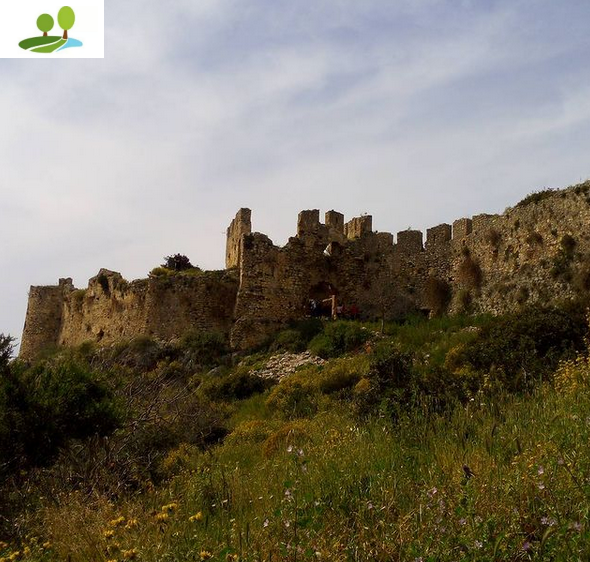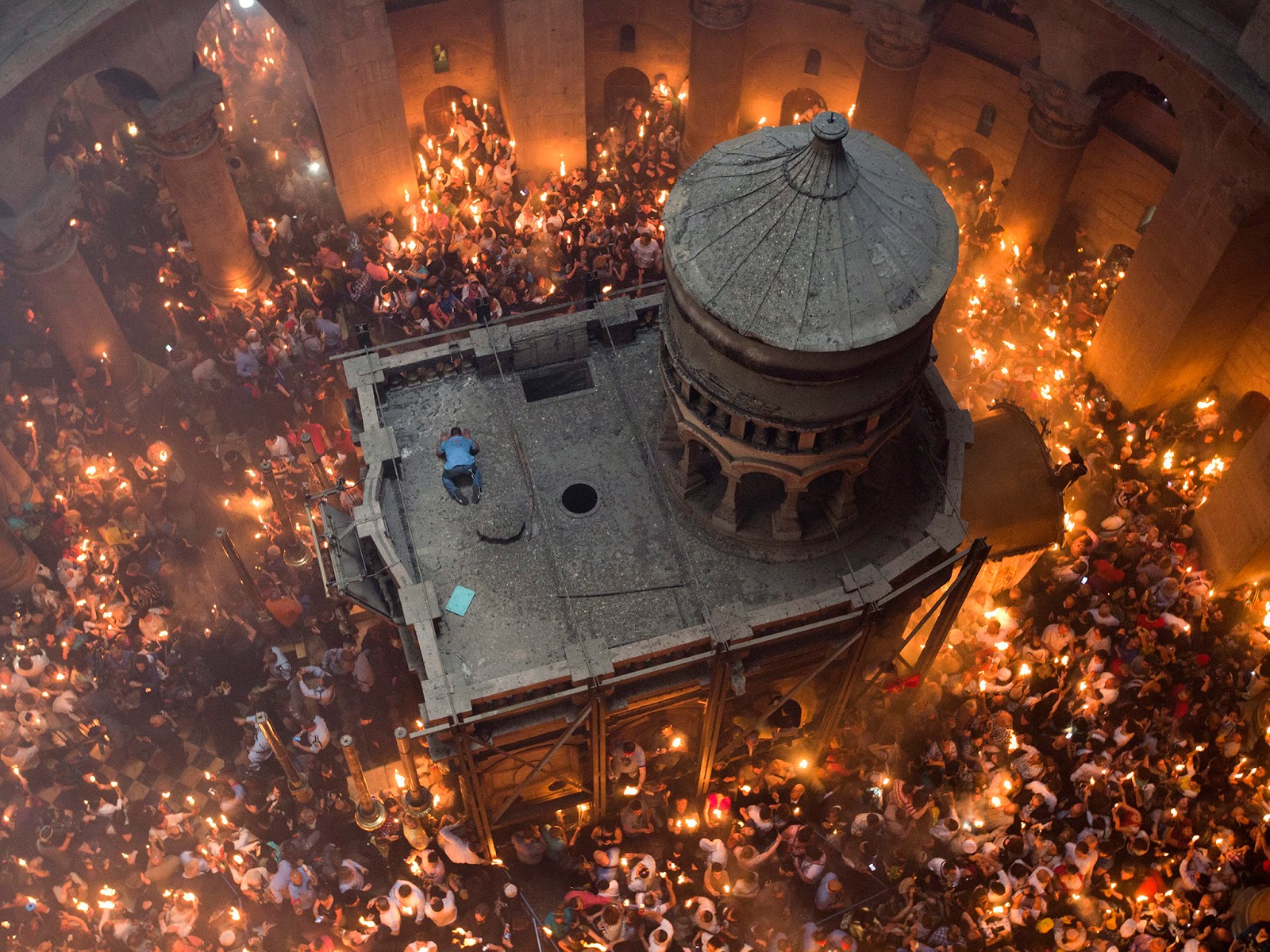Restoration work at the Church of the Holy Sepulchre in Jerusalem reveals one of world's holiest sites rests on a precarious earthly foundation.
A scientific team from the National Technical University of Athens
(NTUA), which has just completed the restoration of what is
traditionally believed to be the tomb of Christ in Jerusalem, warns that
additional work is needed to prevent the shrine and surrounding complex
from experiencing significant structural failure.
'When it fails, the failure will not be a slow process, but
catastrophic," says Antonia Moropoulou, NTUA's chief scientific
supervisor.
The Edicule (from the Latin aedicule, or "little house"), a
small structure within the Church of the Holy Sepulchre, encloses the
remains of a cave that has been venerated since at least the fourth
century A.D. as the tomb of Jesus Christ.
Restoration of the Edicule reveals that much of the 19th-century
shrine and its surrounding rotunda, which host millions of annual
visitors, appear to be built largely on an unstable foundation of
crumbled remnants of earlier structures and is honeycombed with
extensive tunnels and channels.
While the year-long restoration of the Edicule is being celebrated
today in Jerusalem with a ceremony at the church, scientists and church
leaders are grappling with the new evidence for significant risks that
the engineering work has revealed.
Layers of History Pose Risk to Future
The most recent NTUA report provided to National Geographic reveals
that much of the risk posed to the tomb is due to the rich history of
the venerated site.
Archaeologists believe that some 2,000 years ago, the site was the
location of a defunct limestone quarry that eventually housed tombs of
the Jewish upper class. At least half a dozen such tombs have been
identified within the grounds of the church, in addition to the tomb
traditionally believed to be the burial place of Jesus.
A Roman temple built on the site in the second century was razed by
Constantine, the first Christian emperor of Rome, around 324 A.D to
reveal what was believed to be the tomb of Christ.
The shrine built by Constantine around the tomb was partly destroyed
by Persian invaders in the seventh century A.D. and destroyed again by
the Fatimids in 1009. The church was rebuilt in the mid-11th century.
The Edicule was later altered by the Crusaders and restored again in the
16th and early 19th centuries. Its current form encloses several
earlier construction phases.
The domed rotunda that surrounds the Edicule is believed to mark the
footprint of the original Constantinian church, and possibly the Roman
temple that preceded it.
Tunnels Beneath the Tomb of Christ
The recent survey beneath the floor of the Edicule and rotunda,
conducted during the restoration project, confirmed some of what
scientists have long suspected while revealing previously unknown risks
to the stability of the entire 3,000-square-foot survey area.
Ground-penetrating radar, robotic cameras, and other tools show that
some portions of the Edicule's foundation sit on the rubble of earlier
buildings. Other parts rest directly on the brink of very steeply
sloped, quarried bedrock. Foundation mortar has crumbled due to decades
of exposure to moisture from drainage channels that run several feet
beneath the rotunda floor.
Other unexplained tunnels and voids run directly underneath and
around the Edicule. An eight-foot-deep archaeological trench dug south
of the shrine in the 1960s sits beneath an unsupported concrete slab in
an area where visitors have lined up to enter the tomb.
Several of the 22-ton pillars that hold up the dome of the rotunda rest on more than four feet of unconsolidated rubble.
The Successful Restoration of the 'Little House'
The structural integrity of the Edicule has been a concern for nearly
a century, but disagreements among the different Christian sects that
claim custody of the church, as well as a lack of financial resources,
long hindered its repair.
The Edicule (from the Latin aedicule, or "little house"), a
small structure within the Church of the Holy Sepulchre, encloses the
remains of a cave that has been venerated since at least the fourth
century A.D. as the tomb of Jesus Christ.
Restoration of the Edicule reveals that much of the 19th-century
shrine and its surrounding rotunda, which host millions of annual
visitors, appear to be built largely on an unstable foundation of
crumbled remnants of earlier structures and is honeycombed with
extensive tunnels and channels.
While the year-long restoration of the Edicule is being celebrated
today in Jerusalem with a ceremony at the church, scientists and church
leaders are grappling with the new evidence for significant risks that
the engineering work has revealed.
Layers of History Pose Risk to Future
The most recent NTUA report provided to National Geographic reveals
that much of the risk posed to the tomb is due to the rich history of
the venerated site.
Archaeologists believe that some 2,000 years ago, the site was the
location of a defunct limestone quarry that eventually housed tombs of
the Jewish upper class. At least half a dozen such tombs have been
identified within the grounds of the church, in addition to the tomb
traditionally believed to be the burial place of Jesus.
A Roman temple built on the site in the second century was razed by
Constantine, the first Christian emperor of Rome, around 324 A.D to
reveal what was believed to be the tomb of Christ.
The shrine built by Constantine around the tomb was partly destroyed
by Persian invaders in the seventh century A.D. and destroyed again by
the Fatimids in 1009. The church was rebuilt in the mid-11th century.
The Edicule was later altered by the Crusaders and restored again in the
16th and early 19th centuries. Its current form encloses several
earlier construction phases.
The domed rotunda that surrounds the Edicule is believed to mark the
footprint of the original Constantinian church, and possibly the Roman
temple that preceded it.
Tunnels Beneath the Tomb of Christ
The recent survey beneath the floor of the Edicule and rotunda,
conducted during the restoration project, confirmed some of what
scientists have long suspected while revealing previously unknown risks
to the stability of the entire 3,000-square-foot survey area.
Ground-penetrating radar, robotic cameras, and other tools show that
some portions of the Edicule's foundation sit on the rubble of earlier
buildings. Other parts rest directly on the brink of very steeply
sloped, quarried bedrock. Foundation mortar has crumbled due to decades
of exposure to moisture from drainage channels that run several feet
beneath the rotunda floor.
Other unexplained tunnels and voids run directly underneath and
around the Edicule. An eight-foot-deep archaeological trench dug south
of the shrine in the 1960s sits beneath an unsupported concrete slab in
an area where visitors have lined up to enter the tomb.
Several of the 22-ton pillars that hold up the dome of the rotunda rest on more than four feet of unconsolidated rubble.
The Successful Restoration of the 'Little House'
The structural integrity of the Edicule has been a concern for nearly
a century, but disagreements among the different Christian sects that
claim custody of the church, as well as a lack of financial resources,
long hindered its repair.
Text:
http://news.nationalgeographic.com/2017/03/jesus-christ-tomb-jerusalem-restored-collapse-tunnels/
Photos:
Google Images










Δεν υπάρχουν σχόλια :
Δημοσίευση σχολίου